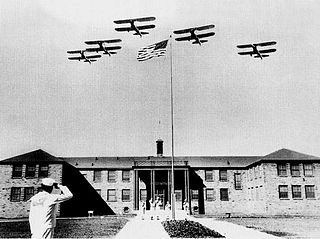
NAS Ottumwa's Administration Building Being Overflown by Trainer Aircraft
Naval Air Station Ottumwa was constructed as a Naval Training Center shortly after America's entry into World War II. The Navy, faced with providing aviators and support personnel for a two-front war, began a massive campaign of rapid expansion.
Cache is placed near the Administration Building, which is being refurbished to become a museum. Use stealth when finding the cache.
On April 15, 1942 the U.S. Navy Site Selection Board met with Ottumwa city officials and determined a 1,400 acre tract of land a few miles north of the city would be a suitable location for a primary flight training facility. Based on their recommendation, Navy Secretary Frank Knox approved the location on July 9, 1942, and on August 6, 1942 groundbreaking for the base was held. The first group of Naval Aviation Cadets arrived at the base on March 10, 1943 and flight training officially began four days later. Another first for NAS Ottumwa occurred on May 30, 1943 when the first group of U.S. Navy WAVES arrived. At its peak, NAS Ottumwa was averaging one thousand flight hours per day, and over 600,000 flight hours logged by the time the base was closed. Aircraft used in flight training were mostly the SNJ, the N3N Canary, and the N2S Kaydet. Around sixty buildings—hangars, control tower, barracks, classrooms and sundry others—were built for the Navy's use. The base avenues were named for U.S. Navy aircraft carriers that served early in World War II: Enterprise, Hornet, Langley, Lexington, Wasp and Yorktown. Streets were named for U.S. Navy Admirals Dewey, Farragut, Moffett, and Sims along with Marine Corps General Smedley Butler and American Revolutionary War naval hero John Paul Jones. One thing that set NAS Ottumwa apart from most other temporary Naval air training facilities around the nation was the quality of materiels used in construction.Wood-frame, clapboard-sided buildings were the norm at most bases, However concerned about the poor quality of wood available for base construction due to a nationwide shortage and the delays that might ensue at NAS Ottumwa, the base commander instead sought out other construction materiels. Ottumwa Brick and Tile, a factory located not far from the NAS Ottumwa site, provided high-quality, durable brick for the base construction. Because of that, several of the buildings, approximately fourteen in various states of disrepair, remain. A series of 19 auxiliary landing strips, mostly unpaved, were also established within a 25-mile radius of Ottumwa.
Among the thousands of Navy personnel who served at the base was Richard M. Nixon, later U.S. Vice-President and President. Nixon was stationed at NAS Ottumwa from October 1942 until May 1943. Several other notables also served at NAS Ottumwa, including Scott Carpenter, one of the seven Project Mercury astronauts and the second American to orbit the Earth. College Football Hall of Famer Bob Steuber, and Jesse L. Brown, the U.S. Navy's first African-American pilot. In all, over 4,600 naval aviators earned their "wings of gold" at NAS Ottumwa during its history.

NAS Ottumwa from above in the 1940s'
With the end of World War II and much less need for large numbers of aviators, NAS Ottumwa was transitioned from a flight training role to one of classroom-based pre-flight training on December 7, 1945—exactly four years after the Japanese attack on Pearl Harbor.
On May 20, 1947 the U.S Secretary of the Navy ordered that the U.S. Navy Pre-Flight school at NAS Ottumwa be moved to NAS Pensacola. This was completed by October 1947, with the last Navy plane leaving Ottumwa on October 2. The City of Ottumwa acquired the base by lease on October 20, 1947. Outright ownership would be granted to the city on September 16, 1957. Efforts to save part of the airport's naval aviation past are currently underway. The Administration Building from NAS Ottumwa is being restored by the non-profit group Friends of the Naval Air Station Ottumwa. The building, which had been unused since 1984, was in a state of considerable disrepair when the group took over its care. Once renovations are done it will repurposed as a Naval air and space museum. In June, 2013 the administration building was approved for listing on the National Register of Historic Places. It is one of only fourteen buildings built for and used by NAS Ottumwa still existing.

Aviation Caches
Aviation Cache: A-7D Corsair II 71-0213
Aviation Cache: A-7D Corsair II 71-0334
Aviation Cache: A-7D Corsair II 71-0254
Aviation Cache: And Then There Were Three
Aviation Cache: AH-1 Cobra
Aviation Cache: Ames Municipal / Wearth Airport
Aviation Cache: B-17F 42-30535
Aviation Cache: B-17G 42-97224
Aviation Cache: B-24 41-29052 Crash Site
Aviation Cache: The Cyclone Post
Aviation Cache: F-86L Sabre 53-0750
Aviation Cache: Aviation Cache: F-80 Midair Collision 10/22/1954
Aviation Cache: Hap Westbrook
Aviation Cache: Hunter Field
Aviation Cache: I Hear The Choppers Coming
Aviation Cache: Lamotte Air Defense Radar Station
Aviation Cache: MERLE
Aviation Cache: Morningstar Field / North Field
Aviation Cache: NAS Ottumwa
Aviation Cache: NAS Ottumwa Auxiliary Airfield #10
Aviation Cache: The Parakeet Casualty
Aviation Cache: Phantom
Aviation Cache: Scorpion Down - December 9, 1968
Aviation Cache: The Silent Knights
Aviation Cache: T-33 Shooting Star 51-4406
Aviation Cache: T-33 Shooting Star 53-5916
Aviation Cache: T-33 Shooting Star 58-0579
Aviation Cache: Thunderflash
Aviation Cache: Thunderstreak
Aviation Cache: The Vantage